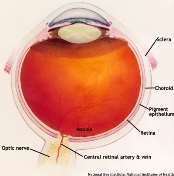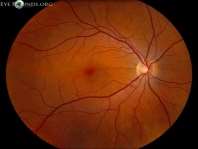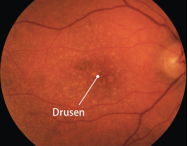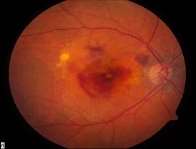Background:
Age-Related Macular degeneration (AMD) is a painless disease that usually affects people over the age of 60. The Macular is the part of the fundus which is responsible for the patient’s central vision which allows them to see in fine detail and aids in facial & object recognition. The patient’s peripheral vision is not affected so AMD does not result in complete blindness.
 The diagram shows the positions of the main structures inside a normal healthy eye such as the macula & optic nerve.
The diagram shows the positions of the main structures inside a normal healthy eye such as the macula & optic nerve.
The general symptoms that a patient with AMD would experience are:
 (Symptoms taken from www.nhs.uk website)
(Symptoms taken from www.nhs.uk website)
There are 2 types of AMD, Wet and Dry, the clinical presentations and the symptoms the patient experiences differ.
Wet AMD occurs when the retinal pigment epithelium (RPE) underneath the retina at the macula thickens and then breaks. The oxygen supply to the macula is disrupted and the body responds by abnormally growing new blood vessels through the RPE towards the macula to help increase oxygen supply, this can cause the macula to appear raised. The new vessels are fragile and poor quality so leak or bleed. This causes atrophy to the macula which results in rapid decline in central vision. Wet AMD is the most sight threatening of the 2 types as once the vision has be lost it cannot be regained again but there are treatments that can help slow the progression of the disease such as Anti-VEGF injections which stop/slow the growth of the new abnormal vessels. (www.nhs.uk)
Dry AMD is the most common form of AMD, around 90% of cases. The clinical presentation of dry AMD is drusen appearing at or around the macula area. Drusen looks like white/yellow dots, they can be small and well defined or large and blurred margins. Drusen occurs as the eye may have a problem with disposing waste from the photoreceptors and so calcium and lipid deposits build up. The retinal pigment epithelium layer may thin and the drusen will push through. The drusen then causes photoreceptor death/degeneration causing atrophy of the retina. This is when the patient’s vision will start to reduce. It is a much slower disease process than wet AMD, it can be a couple of months before the patient experiences any symptoms relative to dry AMD. (www.AMD.org)
 Normal Fundus Wet AMD Dry AMD
Normal Fundus Wet AMD Dry AMD





Stem Cells:
Stem cells are undifferentiated cells which can differentiate into specialised cells such as muscle, skin and bone cells. In mammals there are 2 types of stem cells this depends on the source which they are taken from; these are embryos which are 4-5 days old in the blastocyst phase and in adult tissues throughout the body such as bone marrow, the brain and skeletal muscle tissue. (www.medicalnewstoday.com)
The first trial was on 2 patients who were in late stage of AMD; they underwent immunosuppressive treatment to reduce a negative response to the new stem cells. The embryonic source is chosen for this treatment, the researchers used mouse skin cells to help the stem cells to differentiate into retinal cells. They are then purified so not contaminated by mouse cells. These purified retinal cells are then made into a 1ml solution and injected into only one eye (this is done in trials as they don’t know if the treatment will have a damaging or successful effect on the eye). The general results from this trial were good; one patient had Stargardt’s macular dystrophy that before treatment could only see hand motions but 2 weeks after transplant was able to count fingers with only the eye that had the transplant carried out in it. Their vision continued to improve over the next 3 months. (www.nhs.uk, Bazian January 2012.)
Structure
-Short intro about what a stem cell and age related macular degeneration is.
-Aim of dissertation; what I want to achieve through the dissertation as a whole.
-Should be roughly 1 page.
-More detail on what they are.
-Different types of stem cells; explain where they are found and when they would be used.
-What type of AMD does this treat and why?
-Background on both types (containing the anatomy of the eye, normal/abnormal)
-Causes
-Epidemiology
-Pathogenesis
-Pathology
-Prevention
-Treatments (current and new)
-How do the stem cells differentiate to photoreceptors & RPE cells? How well does it do this?
-How well does the trials transfer from animals to humans?
-What is the success of these trials?
-Does this look like a viable treatment for AMD?
-Could it be used for either wet/dry or just one?
-What are the advantages/disadvantages?
-Ethical argument in using stem cells from embryos.
-What I think of the whole argument for and against the treatment
-Do I think it is a viable and effective treatment?
-Do the results from trials back up the theory and argument for stem cells?
-How have the trials been taken further?
-Has any improvements or adjustments been made? E.g. Have administration methods or cell culturing methods changed?
Projected Timetable of Work
|
30/11/16 |
Sections 1, 2 &3; Abstract, Stem cells & What is AMD. |
|
31/12/16 |
Section 4; Potential of stem cells in the treatment of AMD. |
|
31/01/17 |
Section 5; Discussion. |
|
28/02/17 |
Section 6& 7; Conclusion/Perspective & New research. |
|
31/03/17 |
Section 8; References. Dissertation Complete, to be proof read and bound. |
|
13/04/17 |
Final Hand in Date. |
References:
www.amd.org/what-is-macular-degeneration/dry-amd/
www.nhs.uk/conditions/macular-degeneration/pages/introduction.aspx
www.nhs.uk/news/2012/01January/Pages/embyonic-stem-cell-trial-macular-degeneration.aspx, Stem cell therapy ‘safe for eye condition’. January 24, 2012. Analysis by Bazian, edited by NHS Choices.
rgw.com
Webeye.ophth.uiowa.edu
You have to be 100% sure of the quality of your product to give a money-back guarantee. This describes us perfectly. Make sure that this guarantee is totally transparent.
Read moreEach paper is composed from scratch, according to your instructions. It is then checked by our plagiarism-detection software. There is no gap where plagiarism could squeeze in.
Read moreThanks to our free revisions, there is no way for you to be unsatisfied. We will work on your paper until you are completely happy with the result.
Read moreYour email is safe, as we store it according to international data protection rules. Your bank details are secure, as we use only reliable payment systems.
Read moreBy sending us your money, you buy the service we provide. Check out our terms and conditions if you prefer business talks to be laid out in official language.
Read more